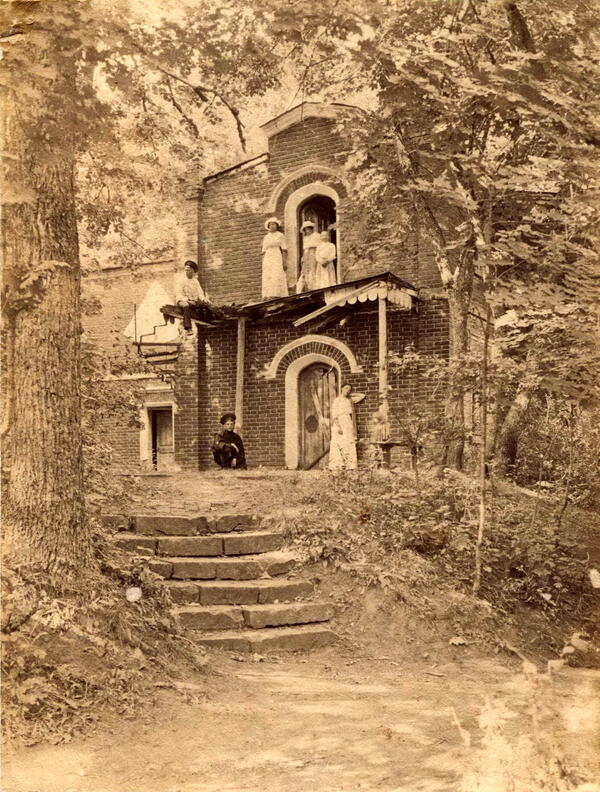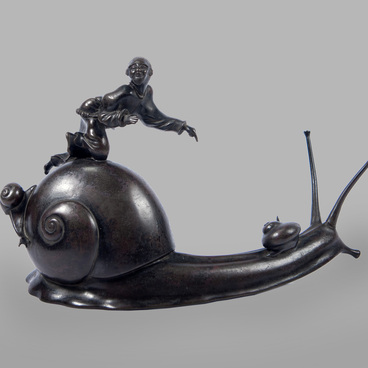In 1798, Abram Andreevich Boratynsky, the poet Yevgeny Boratynsky’s father, retired as a lieutenant-general and went to his Tambov estate of Vyazhlya and settled in the part of it that was called Mara. Abram Andreevich was an energetic person, who could not reconcile with forced idleness, so he got involved in social activities, devoting much time to the household chores on the estate. He created a luxurious estate in Mara with elegant gazebos, bridges, grottos, cascades, stairs and pathways.
1 / 2
Photo of the grotto at the Boratynskys’ estate
Время создания
the early 20th century
Место создания
Kirsanov District, the Russian Empire
Размер
11,2x8,2 cm
Техника
photography
Коллекция
4
Открыть в приложении#9
#13
Abram Andreevich settled in the part of Vyazhlya, which is called Mara and lived in style there. Not far from the house there is a wooded ravine with a water spring gushing out from its bottom. Ponds, cascades, a stone grotto with a secret passage leading to it from the house, gazebos, bridges and pathways were arranged here…
Boris Chicherin, a neighbor of the Boratynsky family, also recalled the park in Mara
#14
The elegiac park in Mara had an extraordinary impact on Yevgeny Boratynsky’s work. His memoirs of its oak groves, the winding paths, the rustle of the trees carried a gentle echo of the past, a nostalgic note in the poet’s letters and poems, “Please write to me: are there currants in our garden, how are the trees growing, how are they cared for, are the paths tidy?” (from the boarding house to his mother in Mara, 1812).
“Staying nearly alone with nature, I see it as a true friend and talk to you about it… I imagine how busy you are with the trees and the vegetable garden now, and I picture it with pleasure — for it is a pleasure for you…” (from Finland to his mother in Mara, 1823).
Today the garden and park are still in a state of disrepair. The withering of the estate began when the poet was still alive. In 1833, Boratynsky visited his “holy canopy” in autumn and left us, his successors, a marvelous picture of the desolation of Mara, which remarkably combines childhood memories of the Mara as it was when his father was alive, with an image of its withering in the gloomy autumn season:
“Staying nearly alone with nature, I see it as a true friend and talk to you about it… I imagine how busy you are with the trees and the vegetable garden now, and I picture it with pleasure — for it is a pleasure for you…” (from Finland to his mother in Mara, 1823).
Today the garden and park are still in a state of disrepair. The withering of the estate began when the poet was still alive. In 1833, Boratynsky visited his “holy canopy” in autumn and left us, his successors, a marvelous picture of the desolation of Mara, which remarkably combines childhood memories of the Mara as it was when his father was alive, with an image of its withering in the gloomy autumn season:
#15
I walk, where the gazebo smolders,
Where its pillars lie in ashes before it,
Where the bridge’s frame withers.
And thou, majestic grotto,
Of heavy stonework, befallen by destruction
And threatening to fall,
Once in the summer heat, full of coolness, the vault!
Well, let the bygone era pass away as a flying dream.
Still, thou are beautiful, desolate Elysee,
And with a mighty charm
fills my soul.
Yevgeny Boratynsky
#16
In the ravine of the park, there is still the small river Mara — or rather, the stream that is now left of it. The Boratynsky family’s favorite retreat, the stone grotto, is gone.
#17
Entrance to the Boratynskys’ estate, 1924. Photo by M. D. Semechkin
#8
Ministry of Culture of the Russian Federation
читать дальшескрыть
00:00
00:00
1x
Photo of the grotto at the Boratynskys’ estate
Время создания
the early 20th century
Место создания
Kirsanov District, the Russian Empire
Размер
11,2x8,2 cm
Техника
photography
Коллекция
4
Открыть в приложении
Поделиться





